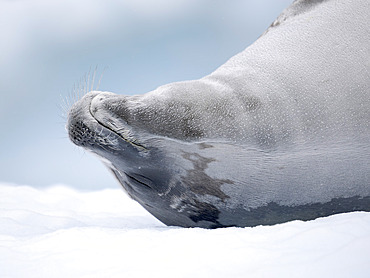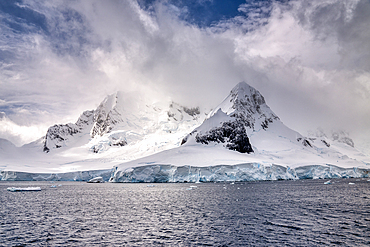Recent searches
Loading...
860-292226 - Crabeater Seal (Lobodon carcinophaga), resting on ice floe. Antarctica, Antarctic Peninsula, Detaille Island
860-292225 - Crabeater Seal (Lobodon carcinophaga), resting on ice floe. Antarctica, Antarctic Peninsula, Detaille Island
1320-301 - Snow-covered mountains at the mouth of the Lemaire Channel, Antarctic Peninsula, Polar Regions
1320-300 - An Antarctic shag (Leucocarbo bransfieldensis), carries sea moss in the Antarctic Peninsula, Polar Regions
1320-299 - An Antarctic shag (Leucocarbo bransfieldensis) carries sea moss in the Antarctic Peninsula, Polar Regions
1320-298 - A Gentoo penguin (Pygoscelis papua), with a rare condition, leucism, in the Antarctic Peninsula, Polar Regions
1320-296 - A Gentoo penguin (Pygoscelis papua), with a rare condition, leucism, in the Antarctic Peninsula, Polar Regions
1320-297 - A Gentoo penguin (Pygoscelis papua), with a rare condition, leucism, in the Antarctic Peninsula, Polar Regions
1320-295 - A Gentoo penguin (Pygoscelis papua), in the Antarctic Peninsula, Polar Regions
1320-294 - A chinstrap penguin (Pygoscelis antarcticus), standing on an iceberg in the Antarctic Peninsula, Polar Regions
1320-293 - An Antarctic shag (Leucocarbo bransfieldensis), standing on top of a rock in the Antarctic Peninsula, Polar Regions
1363-11 - Wandering Albatross on the Southern Ocean near Drake's Passage close to the Antarctic Peninsula, Antarctica, Polar Regions
1363-10 - Two Gentoo penguins fighting over territory on the Antarctic Peninsula, Antarctica, Polar Regions
741-6390 - Gentoo penguins (Pygoscelis papua), Port Lockroy British Antarctic Base, Wiencke Island, Antarctica, Polar Regions
741-6389 - Gentoo penguins (Pygoscelis papua), Port Lockroy British Antarctic Base, Wiencke Island, Antarctica, Polar Regions
741-6388 - Gentoo penguins (Pygoscelis papua), Port Lockroy British Antarctic Base, Wiencke Island, Antarctica, Polar Regions
741-6387 - Gentoo penguins (Pygoscelis papua), Port Lockroy British Antarctic Base, Wiencke Island, Antarctica, Polar Regions
1320-219 - Gentoo penguins (Pygoscelis Papua), performing a mating ritual in the Antarctic peninsula, Antarctica, Polar Regions
1320-218 - Gentoo penguins (Pygoscelis Papua) afloat on an iceberg in the Antarctic peninsula, Antarctica, Polar Regions
1320-217 - A Weddell seal (Leptonychotes weddellii), resting on snow in the Antarctic peninsula, Antarctica, Polar Regions
1320-216 - A floating iceberg in the Antarctic Peninsula, Antarctica, Polar Regions
1320-215 - A portrait of a Gentoo penguin (Pygoscelis Papua), in the Antarctic Peninsula, Antarctica, Polar Regions
1320-214 - A rocky beach with penguins in the Antarctic Peninsula, Antarctica, Polar Regions
1320-213 - An Antarctic blue-eyed shag (Leucocarbo bransfieldensis), sits atop a rock in the Antarctic peninsula, Antarctica, Polar Regions
1363-8 - Sea Ice from above, Antarctic Peninsula, Antarctica
1363-2 - Obscure sun hovering over iceberg. Antarctic Peninsula, Antarctica
832-397830 - South Shetland Island Glacial Landscape Antarctica
832-397831 - South Shetland Island Glacial Landscape Antarctica
832-397832 - South Shetland Islands Admiralty Bay Arctowsky Station Poland Antarctica
741-6135 - Immature Antarctic Shag (Leucocarbo bransfieldensis), Paulet Island, Weddell Sea, Antarctica, Polar Regions
860-291056 - Scuba divers diving around the underwater part of a iceberg, Antarctic Peninsula, Antarctica
860-291052 - Group of Gentoo penguin (Pygoscelis papua). walking in between ice at Cuverville Island, Antarctic Peninsula, Antarctica
860-291053 - Salps, also known colloquially as ?sea grape?) or salpa, salpae or salpas is a barrel-shaped, planktic tunicate. Antarctic Peninsula, Antarctica
860-291054 - Anemone (Urticinopsis antarctica). It is a filter feeder and opportunistic predator. Antarctic Peninsula, Antarctica
860-291055 - Estrella sea star (Labidiaster annulatus) is a species of starfish in the family Heliasteridae. It is found in the cold waters around Antarctica and has a large number of slender, flexible rays. Antarctic Peninsula, Antarctica
860-291051 - Gentoo penguin (Pygoscelis papua). walking on ice at Cuverville Island, Antarctic Peninsula, Antarctica
746-91123 - Antarctic Fur Seal (Arctocephalus gazella) in typical Tussock Grass. Antarctica, Subantarctica, South Georgia, October
746-91124 - Antarctic Fur Seal (Arctocephalus gazella) in typical Tussock Grass. Antarctica, Subantarctica, South Georgia, October
746-91125 - Antarctic Fur Seal (Arctocephalus gazella). Bull. Antarctica, Subantarctica, South Georgia, October
746-91109 - Wreck with Antarctic Fur Seal (Arctocephalus gazella) on the former Flensing Plan. Grytviken Whaling Station in South Georgia. Grytviken is open to visitors, but most walls and roofs of the factory have been demolished for safety reasons. Antarctica, Subantarctica, South Georgia, October
746-91122 - Antarctic Fur Seal (Arctocephalus gazella) in the former Whaling Station Grytviken. Antarctica, Subantarctica, South Georgia, October
746-91121 - Antarctic Fur Seal (Arctocephalus gazella) in typical Tussock Grass. Antarctica, Subantarctica, South Georgia, October
1112-6506 - A pair of adult bull Antarctic fur seals (Arctocephalus gazella), fighting in Right Whale Bay, South Georgia, South Atlantic, Polar Regions
1112-6509 - Antarctic fur seal pups (Arctocephalus gazella), playing underwater in Stromness Harbor, South Georgia, South Atlantic, Polar Regions
1112-6508 - Antarctic fur seal pups (Arctocephalus gazella), playing underwater in Stromness Harbor, South Georgia, South Atlantic, Polar Regions
1112-6512 - A leucistic Antarctic fur seal (Arctocephalus gazella), pup playing with normal pup in Grytviken, South Georgia, South Atlantic, Polar Regions
1112-6507 - Adult Antarctic fur seal (Arctocephalus gazella), bull and cow on Prion Island, South Georgia Island, South Atlantic, Polar Regions
1112-6511 - A leucistic Antarctic fur seal (Arctocephalus gazella), pup on the beach in Grytviken, South Georgia, South Atlantic, Polar Regions
1112-6513 - A leucistic Antarctic fur seal (Arctocephalus gazella), pup amongst normal pups in Grytviken, South Georgia, South Atlantic, Polar Regions
1112-6510 - An adult female Antarctic fur seal (Arctocephalus gazella), in Moltke Harbor, South Georgia, South Atlantic, Polar Regions
1112-6489 - Snow-covered mountains on Danco Island, in front of the Antarctic Peninsula, Antarctica, Polar Regions
1112-6431 - An adult humpback whale (Megaptera novaeangliae), flukes up dive amongst ice at Brabant Island, Antarctic, Polar Regions
1112-6428 - Gentoo penguin (Pygoscelis papua), at breeding colony during a snowstorm, Brown Bluff, Antarctic Sound, Antarctica, Polar Regions
1112-6420 - An adult gentoo penguin (Pygoscelis papua), feeding a chick at Brown Bluff, Antarctic Sound, Antarctica, Polar Regions
1112-6417 - An adult gentoo penguin (Pygoscelis papua), with chicks at Brown Bluff, Antarctic Sound, Antarctica, Polar Regions
1112-6426 - Gentoo penguin (Pygoscelis papua), with chick during a snowstorm at Brown Bluff, Antarctic Sound, Antarctica, Polar Regions
1112-6416 - An adult gentoo penguin (Pygoscelis papua), feeding a chick at Brown Bluff, Antarctic Sound, Antarctica, Polar Regions
1112-6418 - An adult gentoo penguin (Pygoscelis papua), with chicks at Brown Bluff, Antarctic Sound, Antarctica, Polar Regions
1112-6419 - An adult gentoo penguin (Pygoscelis papua), with chicks at Brown Bluff, Antarctic Sound, Antarctica, Polar Regions
1112-6427 - Gentoo penguins (Pygoscelis papua), at breeding colony during a snowstorm, Brown Bluff, Antarctic Sound, Antarctica, Polar Regions
1112-6360 - An adult Antarctic shag (Leucocarbo bransfieldensis), in flight with nesting material on Paulet Island, Antarctica, Polar Regions
1112-6363 - Antarctic shags (Leucocarbo bransfieldensis), feeding chick on Brabant Island, Antarctica, Polar Regions
1112-6362 - An adult Antarctic shag (Leucocarbo bransfieldensis), gathering nesting material on Paulet Island, Antarctica, Polar Regions
1112-6361 - An adult Antarctic shag (Leucocarbo bransfieldensis), gathering nesting material on Paulet Island, Antarctica, Polar Regions
1112-6358 - A bull Antarctic fur seal (Arctocephalus gazella), on the rocks at Coronation Island, South Orkneys, Antarctica, Polar Regions
1112-6338 - Adelie penguin (Pygoscelis adeliae) parent feeding chicks at Brown Bluff, Antarctic Sound, Antarctica, Polar Regions
1112-6346 - Adelie penguins (Pygoscelis adeliae), marching on the beach at Brown Bluff, Antarctic Sound, Antarctica, Polar Regions
1112-6347 - Adelie penguins (Pygoscelis adeliae), breeding colony in a snowstorm at Brown Bluff, Antarctic Sound, Antarctica, Polar Regions
1112-6339 - Adelie penguin (Pygoscelis adeliae) parent feeding chicks at Brown Bluff, Antarctic Sound, Antarctica, Polar Regions
1112-6337 - Adelie penguin (Pygoscelis adeliae) parent feeding chick at Brown Bluff, Antarctic Sound, Antarctica, Polar Regions
1112-6349 - Adelie penguins (Pygoscelis adeliae), marching on the beach in a snowstorm, Brown Bluff, Antarctic Sound, Antarctica, Polar Regions
1112-6345 - Adelie penguins (Pygoscelis adeliae), marching on the beach at Brown Bluff, Antarctic Sound, Antarctica, Polar Regions
1112-6340 - Adelie penguin (Pygoscelis adeliae), parent on a chick and egg at Brown Bluff, Antarctic Sound, Antarctica, Polar Regions
1112-6344 - Adelie penguins (Pygoscelis adeliae), marching on the beach at Brown Bluff, Antarctic Sound, Antarctica, Polar Regions
1112-6348 - Adelie penguins (Pygoscelis adeliae), breeding colony in a snowstorm at Brown Bluff, Antarctic Sound, Antarctica, Polar Regions
1112-6359 - An Antarctic petrel (Thalassoica antarctica), in flight at sea on the way to Peter I Island, Antarctica, Polar Regions
832-395881 - Southern rockhopper penguin (Eudyptes chrysocome), with young, West Point, Falkland Islands, South America
832-395884 - Southern rockhopper penguin (Eudyptes chrysocome), West Point, Falkland Islands, South America
832-395890 - Icebergs, pack ice in the foreground, Antarctica
832-395883 - Southern rockhopper penguin (Eudyptes chrysocome), West Point, Falkland Islands, South America
832-395882 - Southern rockhopper penguin (Eudyptes chrysocome), hopping over rocks, West Point, Falkland Islands, South America
1350-5725 - Man portrait in Gojahaven, an Inuit settlement in the far north of Canada
1350-5721 - Frozen fish in Gojahaven, an Inuit settlement in the far north of Canada
1350-5696 - Portrait of young boy in Gojahaven, an Inuit settlement in the far north of Canada.
1350-5712 - School in Gjohaven, an inuit settlement in the far north of Canada
1350-5708 - School drawings in Gojahaven, an Inuit settlement in the far north of Canada.
1350-5729 - Men look for animals to hunt in Gojahaven, an Inuit settlement in the far north of Canada.
1350-5732 - Young boy in Gjohaven, an inuit settlement in the far north of Canada
1350-5704 - Building an igloo in Gojahaven, an Inuit settlement in the far north of Canada
1350-5705 - Building an igloo in Gojahaven, an Inuit settlement in the far north of Canada
1350-5707 - School drawings in Gojahaven, an Inuit settlement in the far north of Canada.
1350-5709 - Building an igloo in Gojahaven, an Inuit settlement in the far north of Canada
1350-5700 - Portrait of young boy in Gojahaven, an Inuit settlement in the far north of Canada.



































































































